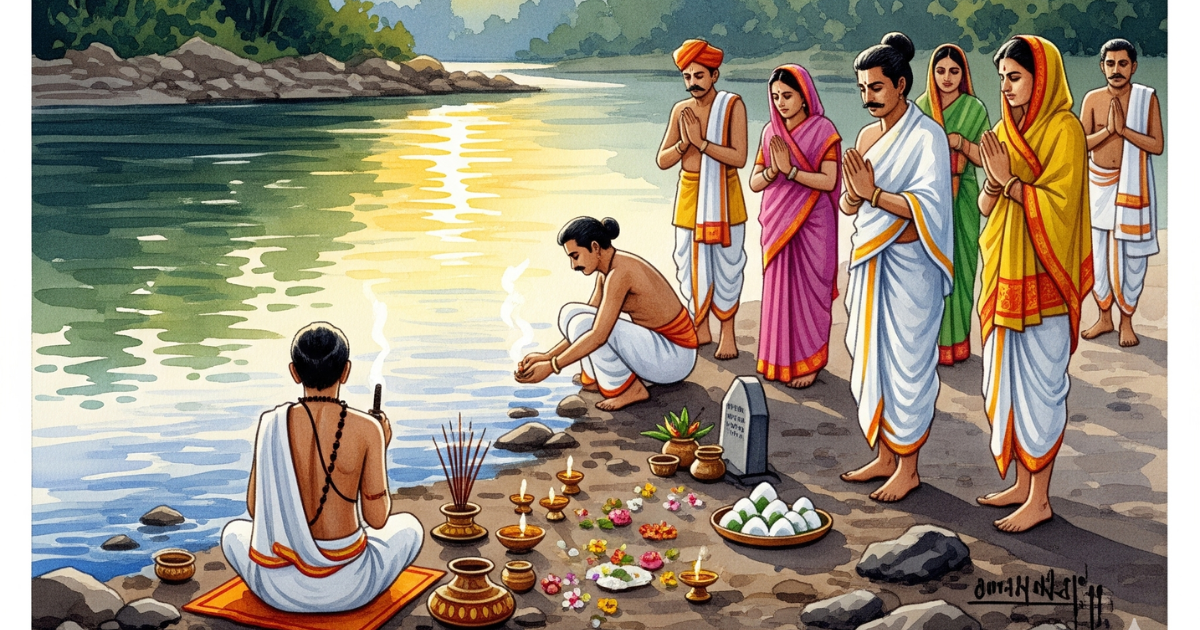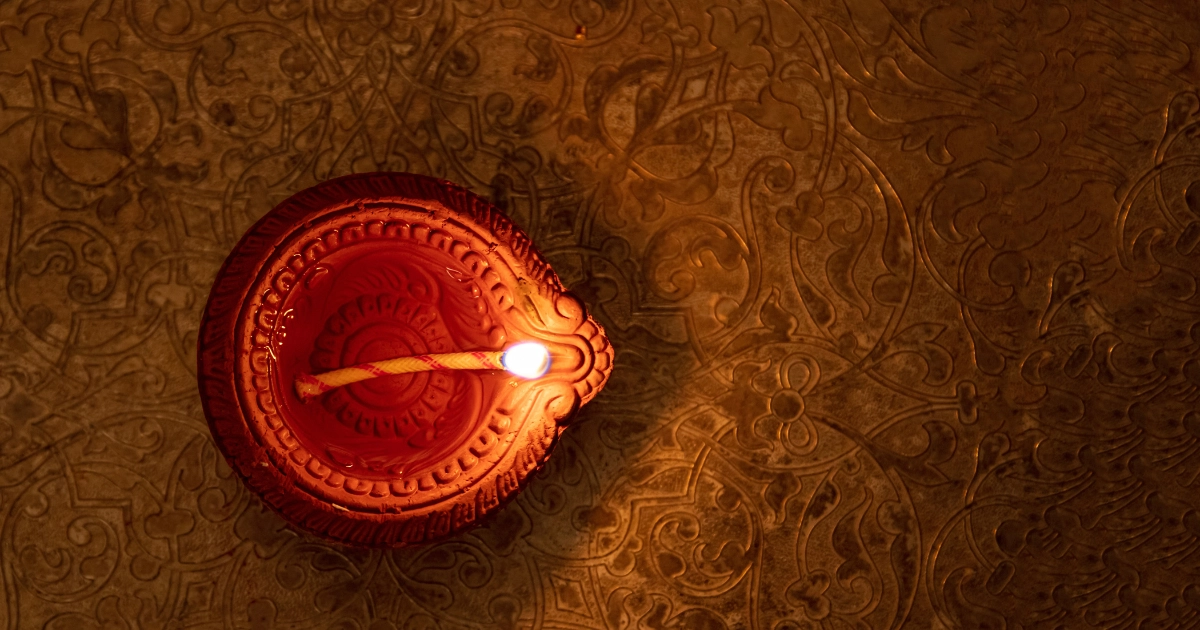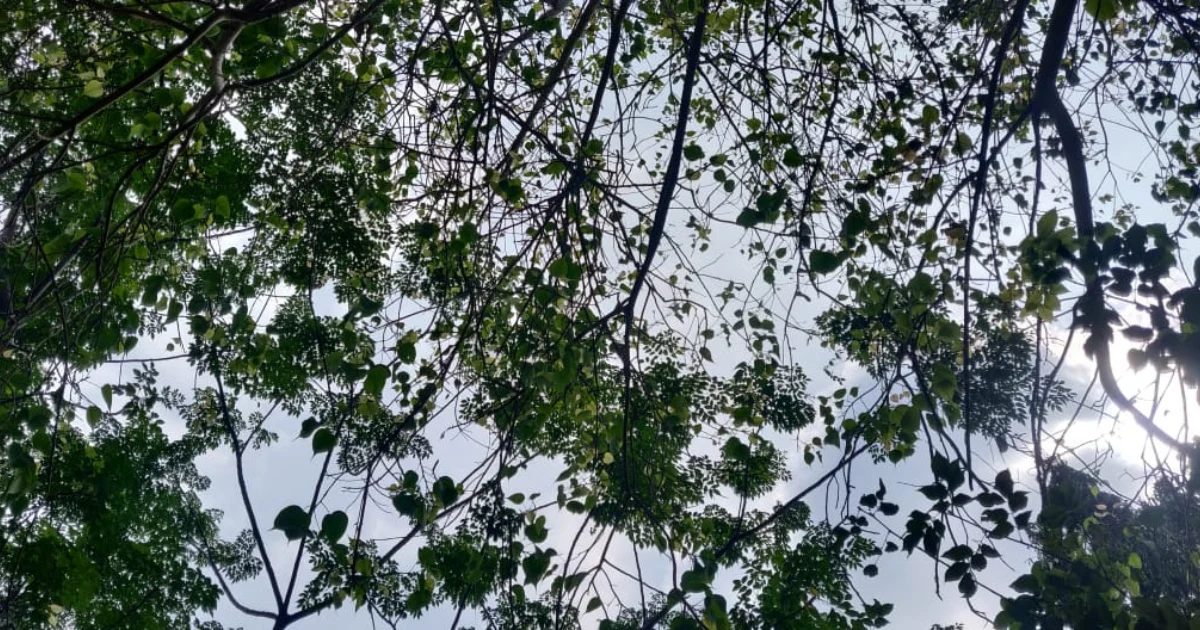Pitṛ anugraha (departed ancestors’ divine grace) is very much needed to obtain whatever is needed in this life while living in this mṛtyuloka.
In the Bṛhadāraṇyaka (6.2.1-16) and Chāndogya (5.10.1-10) Upaniṣad, the conversation between Śvetaketu, the grandson of Aruṇa, and King Pravāhaṇa, in the assembly of the Pañcālas, describes the various lokas, and the transmigration of the departed ancestors through these, based on their deeds when alive, as well as the after-death rituals performed by their descendants.
Pitṛs descend on Āṣāḍḥa pūrṇimā and reside in their descendants' houses until Kārtika pūrṇimā. However, it is only during the Bhādrapada kṛṣṇa pakṣa/pitṛ pakṣa that they seek to be propitiated.
And, beginning from Naraka Caturdashī they start to return to their realms/abodes until Kārtika pūrṇimā.
It is important to note that if this tradition of male heirs offering śrāddha rituals to pitṛs is not performed, the discontented pitṛs get angered with them, leading to many obstacles and difficulties in life for their descendants.
An exception to this is, that on the Sarva Pitṛi Amāvasya day, even a daughter’s son can perform the śrāddha for maternal ancestors in the absence of a male heir in the mother’s family.
It is also an important ritual as it helps perform another social custom of remembering and passing on the names and memories of one’s ancestors up to six generations. So, it also performs a kind of record-keeping because continuity and solidarity of the lineages are what give stability in a society.
The speciality of the Pitṛ pakṣa or Mahālaya pakṣa
As per our scriptures, there are 96 days in the year when one can perform śrāddha for their 3 generations of departed ancestors on the maternal and paternal sides.
However, the Pitṛ pakṣa or the Mahālaya pakṣa gives one the opportunity to do perform śrāddha for all blood relations that have departed as well as for one’s non-blood relations like friends, gurus, and anyone they wish to perform a śrāddha for.
Scriptural references
Skanda Purāṇa - Section-Tīrtha Mahātmya - Chapter 216 - Origin of Śrāddha
King Ānarta inquires why śrāddha (rituals for ancestors) is specifically performed on amāvāsyā (new moon) when there are many other auspicious days.
Bhartṛyajña replies that while there are several propitious times for śrāddha, such as:
- Manvādis (Manvantara beginnings)
- Yugādis (Yuga beginnings)
- Saṅkrāntis (Sun's transit days)
- Vyatīpātas, Gajacchāyā, and eclipses (grahanas)
However, amāvāsyā is the most suitable because it is directly linked to the ancestors' satisfaction. On amāvāsyā, the sun's rays are obscured, and the moon merges with the sun, symbolizing the union of day and night, which makes it spiritually potent.
Categories of Pitṛs
There are nine divine groups of pitṛs, whom the devas propitiate:
- Agniṣvāttas
- Barhiṣads
- Ājyapas
- Somapās
- Raśmipas
- Upahūtas
- Āyantunas (invoked by “āyantu” hymns)
- Śraddhabhuks
- Nāndīmukhas
- Human Pitṛs - Pitṛs of human origin also reside in svarga due to their past good deeds.
They are classified as:
- Saṃhṛṣṭas – Happy ancestors whose descendants offer śrāddha regularly.
- Duḥkhitas – Distressed ancestors suffering from hunger and thirst as their descendants' neglect śrāddha.
The Suffering of the Human Pitṛs
The human pitṛs, despite being in celestial regions, suffer from hunger and thirst when their descendants fail to perform śrāddha.
They describe their plight:
- They have access to celestial trees and fruits, but cannot pluck or eat them.
- Even the water from the celestial Gaṅgā evades their grasp.
They plead with the divine pitṛs for a solution, explaining that although they are in svarga, they feel as if they are in the torments of naraka.
The Solution from Brahmā
The divine pitṛs, moved by the plight of the human pitṛs, take them to Lord Brahmā, the creator. The pitṛs request Brahmā to arrange for their permanent satisfaction.
-
Brahmā’s first solution:
- Śrāddha performed by descendants on amāvāsyā would ensure their satisfaction for one month.
- It should be done with:
- Libations of water mixed with sesame seeds.
- Offerings of cooked rice and piṇḍas (rice balls).
Pitṛs feel temporarily satisfied, but as time passes, human descendants become negligent, and the pitṛs suffer again.
Establishment of Pretapakṣa (Fortnight of the Departed)
- Seeing the pitṛs’ suffering, Brahmā introduces pretapakṣa, a fortnight dedicated to ancestor worship, starting from the fifth fortnight after Āṣāḍha Pūrṇimā.
Śrāddha during Pretapakṣa
- Performing it during this period satisfies the pitṛs for a full year.
- However, when men become wretched or negligent, they stop performing even the annual śrāddha, causing the pitṛs to suffer once more.
Āṣāḍhī Pūrṇimā
The text states that pretapakṣa occurs during the fifth fortnight from the Āṣāḍhī Pūrṇimā, which is the full moon day in the month of Āṣāḍha.
- Āṣāḍha Pūrṇimā typically falls around July. The fortnight (Paksha) immediately following this full moon is the waning phase (kṛṣṇa pakṣa) of Āṣāḍha.
To find the fifth fortnight, we count from the kṛṣṇa pakṣa of Āṣāḍha:
- First fortnight → Āṣāḍha kṛṣṇa pakṣa (waning phase after Āṣāḍhī Purnima)
- Second fortnight → Śrāvaṇa śukla pakṣa (waxing phase of Śrāvaṇa)
- Third fortnight → Śrāvaṇa kṛṣṇa pakṣa (waning phase of Śrāvaṇa)
- Fourth fortnight → Bhādrapada śukla pakṣa (waxing phase of Bhādrapada)
- Fifth fortnight → Bhādrapada kṛṣṇa pakṣa (waning phase of Bhādrapada)
Therefore, the fifth fortnight from Āṣāḍhī pūrṇimā is indeed the kṛṣṇa pakṣa (waning phase) of Bhādrapada, confirming that pretapakṣa occurs during this period.
Why is this fortnight significant?
- During Bhādrapada kṛṣṇa pakṣa, pitṛ pakṣa or pretapakṣa is observed.
- This is the designated time for performing śrāddha rituals to satisfy the ancestors (pitṛs).
- The text also states that this period is especially significant because the sun is in Virgo (Kanyā Rashi), which aligns with the time of pretapakṣa.
Permanent Satisfaction through Gayā Śrāddha
- The pitṛs again appeal to Brahmā.
- Moved with compassion, Brahmā offers a final and permanent solution:
- If descendants offer śrāddha at Gayaśiras (Gayā), the pitṛs will attain everlasting satisfaction.
- Even for a pāpi or one in naraka, śrāddha at Gayā grants liberation.
- Since then, performing śrāddha at Gayā became a revered practice, believed to ensure the salvation of ancestors.
Key Teachings on Śrāddha Practices
- Śrāddha offers immense benefits to both ancestors and descendants.
-
Timings for Śrāddha
- Amāvāsyā (New Moon) → Monthly satisfaction.
- Pretapakṣa → Year-long satisfaction.
- Gayā Śrāddha → Permanent satisfaction.
- Even the poorest person should offer at least one śrāddha yearly to prevent their ancestors from suffering.
-
Neglecting Śrāddha:
- Causes ancestors to suffer from hunger and thirst.
- Brings misfortune and pāpa upon descendants.
- Offering water with sesame seeds is recommended even if one lacks wealth.
The Spiritual Significance of Śrāddha
- Śrāddha is both a duty and a means of spiritual merit.
- It purifies the descendants’ karma and grants prosperity, longevity, and freedom from enemies.
- Listening to or reading the origin of śrāddha grants the same benefits as performing it.
- If the śrāddha is imperfect due to faulty rites or unworthy Brāhmaṇas, simply reciting this narrative rectifies the ritual’s defects.
Brahma Purāṇa – Chapter. 111 – The Details of the Śrāddha Ritual
Summary
According to Vyāsa, when the sun enters the zodiac sign Kanyā (Virgo), the following fifteen days are designated for śrāddha. Performing śrāddha in this period fulfills all desires, with Nāndīmukha Śrāddha especially recommended on pūrṇimā, as per the Varāha Purāṇa.
During the first sixteen days of the Kanyā month, pitṛs from all realms long for offerings. Propitiating them with water, vegetables, and roots during this time yields fruits as rare as those from great sacrifices, such as the Rājasūya and Aśvamedha.
If Śrāddha is done when the sun is in Uttarā or Hastā, the performer attains heaven. From Hastā until the sun enters Vṛścika (Scorpio), pitṛs wander away from home by Yama’s command. When Vṛścika (Scorpio) ends, they return, grieving and cursing negligent descendants.
Additionally, the thirteenth day of the Bhādrapada month is prescribed for śrāddha with rice cooked in milk.
Ṛg Veda 10.15.9
“Come, Agni, to our presence with the pitṛs, who are possessed of knowledge, who, having attained a seat among the devas, thirst (for the Soma), skilled in sacrifices, reciters of praises with hymns, truth-speaking, seers, frequenters of sacrifices.”
Ṛg Veda 10.16.11
“Let Agni, the bearer of the Kavya worship the pitṛs, who are magnified by truth, let him declare which are the offerings to the devas, which to the pitṛs.”
Brahma Purāṇa - Chapter 110 - On the Performance of Śrāddha
This chapter narrates how Viṣṇu, in his boar incarnation (Varāha avatāra), upon the pleas of the pitṛs to remove a curse on them by the Soma deva (Moon), performed a grand ancestral śrāddha ritual using cosmic elements from his own body and nature. Through mantras, offerings, and piṇḍa, he propitiated both devas and pitṛs, restored the cursed pitṛs to their rightful place, and reestablished Soma as their guardian through yoga.
He performed the great ancestral rite at a tīrthsthala called Lohārgala (identified with the present-day Lohaghat in Kumaon). Made fearless by his presence, the pitṛs gathered at Kokāmukha (river/pilgrim site).
Preparations
- From his own body, Varāha produced sacred items: kuśa grass from his hair and sesamum seeds (tila) from his sweat. He also fashioned a torch, vessel, and ritual implements.
- He invoked the elements: waters of Gaṅgā, sacrificial herbs, honey, milk, fragrant flowers, perfumes, a cow from the lake, and gems from the ocean.
- He sanctified the earth with his tusk, perspiration, and firebrand.
Invocation of Deities and Pitṛs
- Invited ṛṣis and received their permission to perform the rite.
- Invoked all devatās, giving them seats and protection with akṣata (unbroken rice and barley), believed to be indestructible and protective.
- Recited mantras (‘āyāntu naḥ’, ‘apahatā’, ‘āpyāyayantu’, etc.) to invite them and protect against asuras.
- Invoked pitṛs by name and gotra, giving them seats of kuśa grass, and offered them arghya (libation) with water, incense, sesamum seeds, and flowers.
Offerings and Fire Ritual
- Made offerings to Soma, Agni, and Yama, reciting yājurvedika mantras.
- Offered food, rice, milk, honey, and perfumes to pitṛs, along with rice-balls (piṇḍa).
- Served Brāhmaṇas with meals of six flavors, fruits, honey, butter, and recited vaidika hymns like Madhu Sūkta, Suparṇa verses, Puruṣa Sūkta, etc.
Piṇḍa and Ancestors
- Rice-balls were dedicated to paternal and maternal ancestors up to the sixth degree.
- Incense, flowers, and cloth were offered to Brāhmaṇas, followed by circumambulation and sprinkling rituals.
- Special mantras were used for pitṛs (akṣayyam naḥ) and for devas (prīyatām).
Completion
- Brāhmaṇas were given silver gifts (dakṣiṇā).
- The remaining food was offered to them, then consumed by Varāha and attendants.
- The pitṛs expressed gratitude: once cursed by Soma to fall from svarga, they were saved by Varāha’s rite.
- They prayed for Soma, the guardian of Yoga, to be their protector again and bless them with prosperity.
Garūḍa Purāṇa, Chapter 10 - Khaṇḍa II - Preta Khaṇḍa:
During the period of śrāddha, even pretas and manes in naraka are released by Yama to partake of the offerings given by their descendants. Hungry and repentant, they long for milk-rice mixed with honey from their sons and grandsons. Hence, descendants must offer it with devotion.
On amāvāsyā, the manes gather at the threshold of their descendants until sunset. If śrāddha is not performed, they return sorrowful and cursing. Therefore, śrāddha on amāvāsyā is vital. Even simple offerings, such as vegetables, when given sincerely, suffice. Performing śrāddha ensures family continuity, prosperity, health, wealth, glory, and protection—its fruits surpass even those rites performed to the devas.
Whatever food, water, or scents touch the earth during the rite reach and gratify the manes, whether they dwell as ghosts, trees, or deities. Through śrāddha, the performer pleases not only the ancestors but the entire universe, up to Brahmaloka.
Benefits:
Śrāddha pleases pitṛs, devas, and humans alike, and brings prosperity in both worlds. Water mixed with sesame seeds is specially recommended. Even a poor man should never neglect śrāddha, for it ensures the ancestors’ peace and protects the family line.
Pitṛ pakṣa days are dedicated to particular ancestors
The general rule is that a tithi corresponding to the demise of a person is the right period to perform their śrāddha with piṇda daan, etc., every year which covers the three generations on both sides.
However, for those who are not sure of the same or are unable to do so, the pitṛ pakṣa period provides particular times and days for the same:
- Cautha Bharaṇī and Bharaṇi Pancamī, the fourth and fifth lunar days respectively, are allocated for people deceased in the past year.
- The ninth day is for married ladies who have predeceased their husbands.
- Twelfth for children and ascetics who have renounced the world.
- The fourteenth for those who have been slain with arms.
The last day of the pitṛ pakṣa, which is commonly known as Sarva Pitṛi Amāvasya, is the day on which śrāddha can be held for any ancestor, including those who have died on specific dates. This is especially for those who have missed the yearly śrāddha or do not remember the date on which their ancestors departed.
Śrāddha Rituals
It is recommended to invite a Brāhmaṇa to help one perform the Śrāddha.
List of Items Needed
Piṇḍa (Rice Balls): Made from cooked rice, black sesame seeds, ghee, and honey.
Please note: Those who aren’t able to perform or prepare these due physical or financial infirmity only, can present to a Brāhmaṇa(s), the swayampāka or dry items of groceries containing the items, from which these can be prepared by the receiver.
Water, and black sesame seeds: For the tarpaṇa and other rituals.
Specific Food Items: Dishes that the departed ancestors liked.
Pitṛ stotram should be chanted.
Significance of Each Item
Piṇḍa: Represents the sustenance and peace offered to the ancestors.
Water: Used in tarpaṇa and other offerings to symbolize purity and devotion.
Preparatory Steps Before the Ritual
1. Personal and Space Cleansing
Personal Cleanliness: The person performing the śrāddha should take a bath and wear clean, preferably white, traditional clothes.
Pūjā Space Preparation: The area where the ritual will be performed should be cleaned thoroughly. It is often sprinkled with Gaṅgā jala to purify it.
2. Invocation of Ancestors
Āvāhanam (Invocation): The ritual begins with the invocation of ancestors by chanting specific mantras and inviting them to partake in the offerings.
Offering of Piṇḍa (Rice Balls)
Preparation of Piṇḍa: Piṇḍas are made from cooked rice mixed with black sesame seeds, ghee, and honey.
Offering Piṇḍa: These rice balls are offered to the ancestors with prayers and mantras, symbolizing sustenance and peace for them.
Tarpaṇa (Water Offering)
Water Offering: Tarpaṇa involves offering water mixed with black sesame seeds to the ancestors. It is done by holding water in the palms and letting it flow into a vessel while chanting mantras.
Prayers and Mantras
Reciting Mantras: Specific mantras and ślokas are recited to honor the ancestors and seek their blessings.
Prayers: Personal prayers and expressions of gratitude are offered to the departed.
Final Offerings and Conclusion
Final Offerings: The ritual concludes with final offerings of food, some flowers and other items.
Pūrṇāhuti (Conclusion): The final step involves offering betel leaves and nuts, and performing āratī to conclude the ceremony.
Post-Pūjā Rituals
Feeding Brāhmaṇas and the Needy: It is customary to feed Brāhmaṇas and offer donations to the needy as part of the ritual.
Sharing the Blessings: Distribute the prasāda (sanctified food) among family members and devotees, symbolizing the shared blessings of the ancestors.
Conclusion
Ancestors are the link to our past and present. It is because of our ancestors that we exist today. Their blessings give us progeny, health, wealth and everything else needed for a comfortable and fruitful mortal existence. Thus, we have a debt or ṛṇa that we need to pay back to them.
Our pitṛ are the mediums between us and the devatās. If they are pleased, they even make the planets favorable towards us.
References
- Kutch in Festival and Custom (Pg 61) by K. S. Dilipsinh https://books.google.co.in/books?id=oPUFiGRH07IC&q=Pitri+paksha&pg=PA66&redir_esc=y#v=onepage&q&f=false
- Chapter XCIX - Mode of performing Sraddhas
- Festivals in Indian Society by Usha Sharma, Vol 2, Chapter on Mahalaya, Pg 71 https://books.google.co.in/books?id=Z6OYRUEAF7oC&q=Pitri+paksha&pg=PA72&redir_esc=y#v=onepage&q=mahalaya&f=false
- Shradh days | 96 Shraddha occasions | Shraddha days in the year
- Chapter 110 - On the performance of Śrāddha and the associated legend
- Garūḍa Purāṇa (3 volumes) by J.L. Shastri - MLBD publishers
- https://archive.org/details/GarudaPuranaEnglishMotilal3VolumesIn1/page/n798/mode/1up
- Chapter 216 - Origin of Śrāddha
- Chapter 111 - The details of the Śrāddha ritual
- Rig Veda 10.15.9 [English translation]
- Rig Veda 10.16.11 [English translation]
- https://pujahome.com/blogs/articles/varshika-shraddha-vidhi-samagri-and-benefits?srsltid=AfmBOoonudQvz54yeni13zMmVG0evrIeEFOoDRPiMbB4YS7adswYX8B6
- श्राद्ध पूजन विधि - १. हम सभी लोग हरि ॐ का गुंजन करेंगे (७बार)
- Shradh days | 96 Shraddha occasions | Shraddha days in the year
-
Sacred Rituals of Mahalaya Paksha | Dr Srinivas Jammalamadaka
- Chandogya Upanishad, Verse 5.10.1-2 (English and Sanskrit)
- Section II - The Process of Rebirth
- पितृ स्तोत्र - Shanti Path







